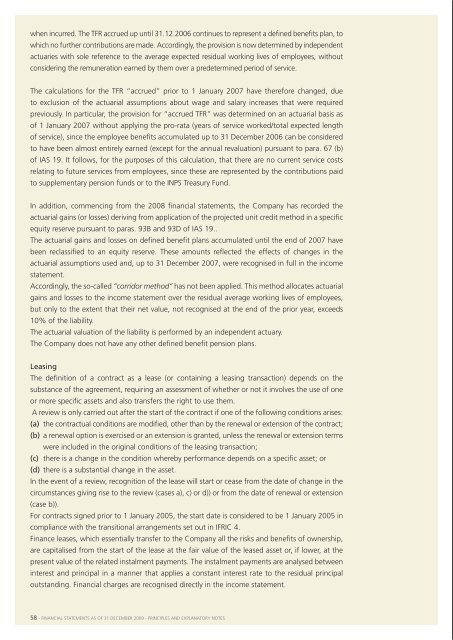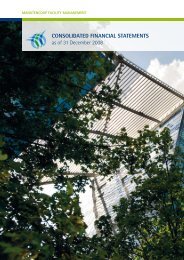Financial Statements 2009 - Manutencoop
Financial Statements 2009 - Manutencoop
Financial Statements 2009 - Manutencoop
You also want an ePaper? Increase the reach of your titles
YUMPU automatically turns print PDFs into web optimized ePapers that Google loves.
when incurred. The TFR accrued up until 31.12.2006 continues to represent a defined benefits plan, towhich no further contributions are made. Accordingly, the provision is now determined by independentactuaries with sole reference to the average expected residual working lives of employees, withoutconsidering the remuneration earned by them over a predetermined period of service.The calculations for the TFR “accrued” prior to 1 January 2007 have therefore changed, dueto exclusion of the actuarial assumptions about wage and salary increases that were requiredpreviously. In particular, the provision for “accrued TFR” was determined on an actuarial basis asof 1 January 2007 without applying the pro-rata (years of service worked/total expected lengthof service), since the employee benefits accumulated up to 31 December 2006 can be consideredto have been almost entirely earned (except for the annual revaluation) pursuant to para. 67 (b)of IAS 19. It follows, for the purposes of this calculation, that there are no current service costsrelating to future services from employees, since these are represented by the contributions paidto supplementary pension funds or to the INPS Treasury Fund.In addition, commencing from the 2008 financial statements, the Company has recorded theactuarial gains (or losses) deriving from application of the projected unit credit method in a specificequity reserve pursuant to paras. 93B and 93D of IAS 19..The actuarial gains and losses on defined benefit plans accumulated until the end of 2007 havebeen reclassified to an equity reserve. These amounts reflected the effects of changes in theactuarial assumptions used and, up to 31 December 2007, were recognised in full in the incomestatement.Accordingly, the so-called “corridor method” has not been applied. This method allocates actuarialgains and losses to the income statement over the residual average working lives of employees,but only to the extent that their net value, not recognised at the end of the prior year, exceeds10% of the liability.The actuarial valuation of the liability is performed by an independent actuary.The Company does not have any other defined benefit pension plans.LeasingThe definition of a contract as a lease (or containing a leasing transaction) depends on thesubstance of the agreement, requiring an assessment of whether or not it involves the use of oneor more specific assets and also transfers the right to use them.A review is only carried out after the start of the contract if one of the following conditions arises:(a) the contractual conditions are modified, other than by the renewal or extension of the contract;(b) a renewal option is exercised or an extension is granted, unless the renewal or extension termswere included in the original conditions of the leasing transaction;(c) there is a change in the condition whereby performance depends on a specific asset; or(d) there is a substantial change in the asset.In the event of a review, recognition of the lease will start or cease from the date of change in thecircumstances giving rise to the review (cases a), c) or d)) or from the date of renewal or extension(case b)).For contracts signed prior to 1 January 2005, the start date is considered to be 1 January 2005 incompliance with the transitional arrangements set out in IFRIC 4.Finance leases, which essentially transfer to the Company all the risks and benefits of ownership,are capitalised from the start of the lease at the fair value of the leased asset or, if lower, at thepresent value of the related instalment payments. The instalment payments are analysed betweeninterest and principal in a manner that applies a constant interest rate to the residual principaloutstanding. <strong>Financial</strong> charges are recognised directly in the income statement.Capitalised assets held under finance leases are depreciated over their estimated useful lives or, ifshorter, over the duration of the lease contract, if it is not reasonably certain that the Companywill obtain full ownership of them at the end of the contract.The cost of operational leases is charged to the income statement on a straight-line basis over thelives of the contracts concerned.Revenue recognitionRevenues are recognised to the extent that the related economic benefits are likely to be obtainedby the Company and the amount can be determined reliably. The following specific recognitioncriteria must be satisfied before the related revenues are recognised in the income statement:ServicesThe principal business of the Company is the provision of services.The principal types of service provided, either individually or as part of contracts for the provisionof Integrated Services, are:> administration and maintenance of property and installations, often associated with the supplyof heat (energy services);> environmental hygiene and cleaning services;> maintenance of green areas;> property management services.Revenues are recognised with reference to the percentage stage of completion of the servicesin progress at the balance sheet date, determined using appropriate variables depending on theservices provided and the contracts signed with the customer (e.g. sq.m, time, costs incurred).Services not completed at the accounting reference date represent "contract work in progress"and are classified among the trade receivables.Any revenues invoiced at the balance sheet date that exceed the amount accrued on a stage ofcompletion basis are deferred as advances from customers and classified together with tradepayables.Even within multi-service contracts, the consideration for each service is generally definedseparately and the amount of the revenues attributable to them is quantified as a reflection oftheir fair value.When the outcome of a service cannot be determined reliably, the related revenues are onlyrecognised to the extent that the costs incurred are deemed to be recoverable.Construction activitiesThe Company records revenues from construction contracts on a stage-of-completion basis,reflecting the percentage of costs incurred with respect to the total estimated cost of completingthe work.When the outcome of a contract cannot be determined reliably, the related revenues are onlyrecognised to the extent that the costs incurred are deemed to be recoverable.Sale of goodsRevenues are recognised on transfer to the purchaser of all significant risks and benefits derivingfrom ownership of the goods.InterestInterest income (calculated using the effective interest method i.e. the rate which exactly discountsthe expected future cash flows generated over the expected life of the financial asset to its netcarrying amount) is recognised on an accruals basis.DividendsDividend income is recognised when the right of the shareholders to receive payment is established.58 - financial statements as of 31 December <strong>2009</strong> - principles and explanatory notes <strong>Financial</strong> statements as of 31 December <strong>2009</strong> - principles and explanatory notes - 59








